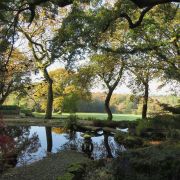
Originally Restormel Castle was probably built of wood shortly after the Norman Conquest. Around 1100 a square projecting gateway was added to this typical motte and bailey style of construction. In the second half of the 13th century, the timber keep was replaced by stone. This circular keep has battlements all around with a complete walk behind them. The internal buildings were rebuilt in stone at the end of the 13th century. At this time, domestic buildings, barracks for the garrison and a chapel were erected.
In 1337 the castle was given to the Black Prince, who was the first Duke of Cornwall. The castle remained the property of the Princes of Wales and still belongs to the Duchy of Cornwall, although it is now administered by English Heritage and is open to the public.
During the English Civil War the castle was besieged and was in a state of ruin by the middle of the 17th century. Over the following two centuries, the castle became covered by ivy and hidden from view in its woodlands. The great circular shell of the keep of Restormel has survived in good condition. The castle was originally entered over a drawbridge, and there is evidence that a second drawbridge once existed within the square gate tower, where some masonry from a very early date can still be found. The water supply originally came from a well chamber in the courtyard, but another source was a spring on the higher ground outside the castle itself. Sections of lead conduit have been found within the buildings and in the surrounding fields.
The bailey, with its accommodation for the retainers, disappeared many years ago, as did the park, where there were once three hundred deer. Today Restormel Castle is a popular picnic spot, surrounded by banks of daffodils and bluebells in the springtime. The views from the top of the castle wall over the valley and the attractive mediaeval town of Lostwithiel are superb.
Restormel Castle is open daily from the beginning of April to the end of October each year. It is located just off the A390 north of Lostwithiel. Historical re-enactments and other events are staged here from time to time.







